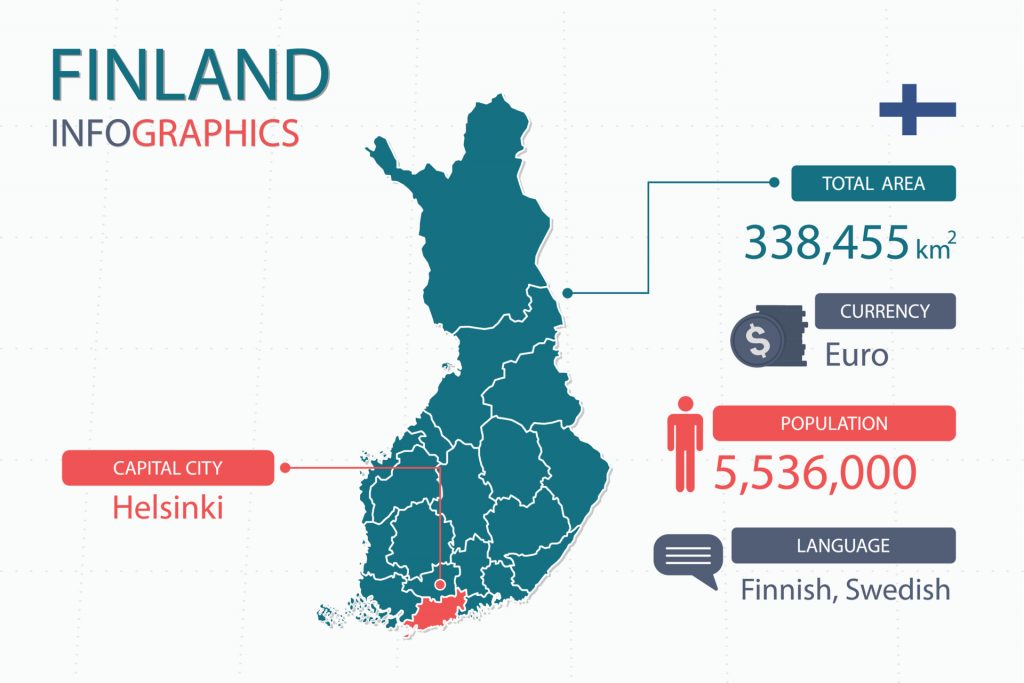The origins of the Finnish Language
Finnish is an official language in Finland (along with Swedish). It is also a recognized minority language in Sweden. About 5.5 million people speak it as a native language. It is also an official language of the EU. (Add something about Kvens)
VEQTA’s English to Finnish and Finnish to English translations by our Finnish English translators are second to none! VEQTA can provide a team of Finnish to English translators with a Finnish Translator who has particular relevant industry background for the type of content you need to translate to Finnish.
Finnish features a number of unique characteristics. First, it is a cross between a fusional and agglutinative language. Essentially, many affixes can be added, or ‘fused’ together to express different shades of meaning, such as tenses. It also contains cases, similar to German or Russian. The Meänkieli and Kven languages are highly related to Finnish and some consider the three dialects of one another.
Finnish belongs to the Finnic group of languages. Other languages in this group include Estonian and other languages around the Baltic Sea. Finnic languages stem from a larger division called the Uralic group, in which Hungarian belongs to as well. Therefore, there are some grammatical and vocabulary relationships between Finnish and Hungarian. Because of how affixes are combined to make newer meanings, Finnish tends to have a smaller core vocabulary; the number of unique words is lower as words have combined to make newer ones over its history. However, it has a number of loan words that originate from a range of languages. These include Turkic languages, other languages in the Baltic region, as well as Germanic and Slavic languages. Many of these loan words have been assimilated and look more ‘Finnish’, more or less, because of the fusional nature of the Finnish language. More recently, Swedish and English have been important sources of loan words. Words relating to administration and cultural aspects have come from Swedish while English has tremendously affected the language of business; English has been widely adopted as the official language of many companies, and thus, English terms relating to corporate structure and business dealings have become more prevalent.

The Finnish writing system was created by a single person, a bishop by the name of Mikael Agricola. The basis of this system is Latin, but drawing from both German and Swedish varieties of it, with Swedish being the stronger influence. Officially, the Swedish alphabet is comprised of 29 letters. In addition to the standard, there are the letters Ä, Ö, and glyphs of S and Z. The additions of the letters are an attempt to capture all the phonemic characteristics that are unique to the Finnish spoken language.
Bishop Agricola had a strong influence in defining the spelling rules of modern Finnish. As a result, the spelling system is generally very regular, which is unlike a system like English or German, or a number of other languages where varieties of letter combinations can be used for the same sound, or where a certain combination of letters can be read in differing ways. In addition, unlike many languages, punctuation is used to separate more grammatical elements of the language from core vocabulary.
In the medieval period, Finnish existed solely as an oral language without a writing system. Thus, business and commerce the region was conducted in Middle Low German, a predecessor to Modern German. Administration and governance on the other hand was conducted in Swedish, and the language of faith and religion, like in many other regions at the time, was Latin. During this period however, the writing system that was previously described was developed by Bishop Mikael Agricola, mainly as a way to translate the Bible from Latin into Swedish, to make it more available to the masses. The writing system that was developed was more based on the Western dialects that existed at the time.
During the 19th century, there was a growing sentiment of Finnish nationalism, and this propelled a sense of urgency to improve the status of Finnish, so that it would become a national language instead of just a local one. Thus, many efforts were made to develop into both a widely spoken and modern language. At this time, it replaced Swedish to become the language of administration and government. In the intellectual and educational realms, it also flourished as the language of science and literature, and perhaps more importantly, the language of journalism, where it was used to communicate with the masses. The first Finnish novel was written in 1870. By the end of the 19th century, it held equivalence with Swedish, a language that was earlier much more widely used for more official and formal purposes.
In the 19th century – a need to improve the status of Finnish.
Nowadays, there are two varieties of Finnish that exist, an Eastern and Western one. The language can also be categorized into three different uses. A standard language is used for mass media and formal situations such as political events, speeches, and newscasts. A book language has also developed, being based on written genres of texts, mainly based on literature, but also found in a variety of other genres. Lastly, there is the spoken language that is prevalent in everyday affairs such as family life, work places, daily transactions, as well as popular media such as TV, radio and internet. The language also is regulated by the Research Institute for the Languages of Finland.
VEQTA can provide you with a perfect Finnish translator for your Finnish translation, English to Finnish translation and Finnish to english translation for the your targeted locale. Our translations to Finnish are created with your target audience in mind to meet your expectations.
If you need to translate Finnish – Get in touch today!
A dedicated team of Finnish translators who combines Experience, Specialized Subject Matter Expertise with Translation Practices to deliver quality second to none.
Finnish Document Translation
Finnish Legal Translation
Finnish I.T Translation
Finnish Health & Fitness Translation
Finnish Medical Translation
Finnish Marketing Translation
Finnish Financial & Accounting Translation
Finnish Tourism & Travel Translation


